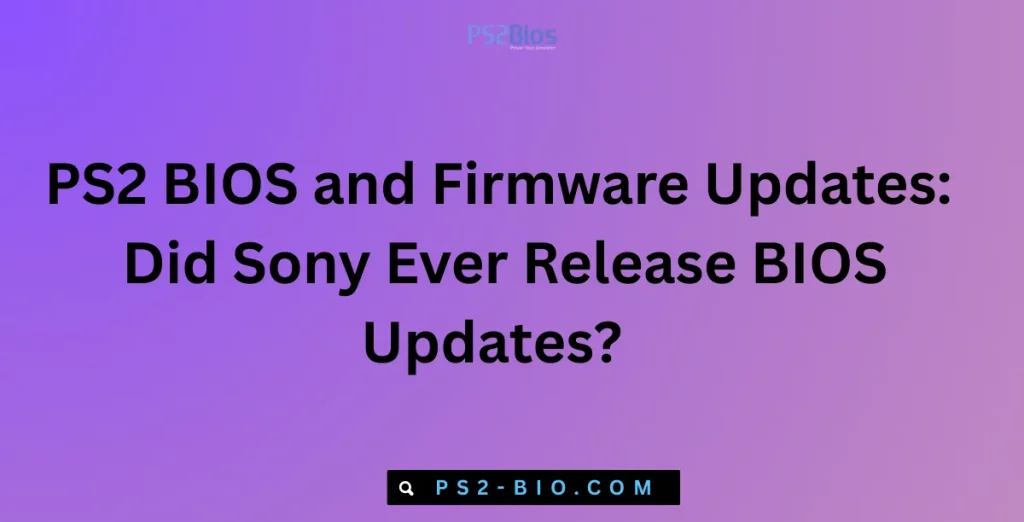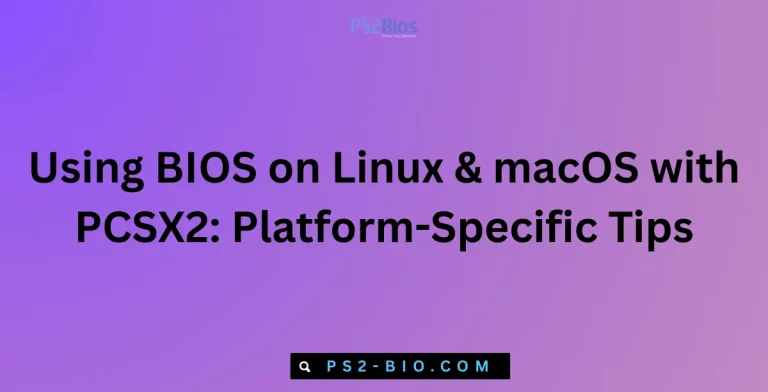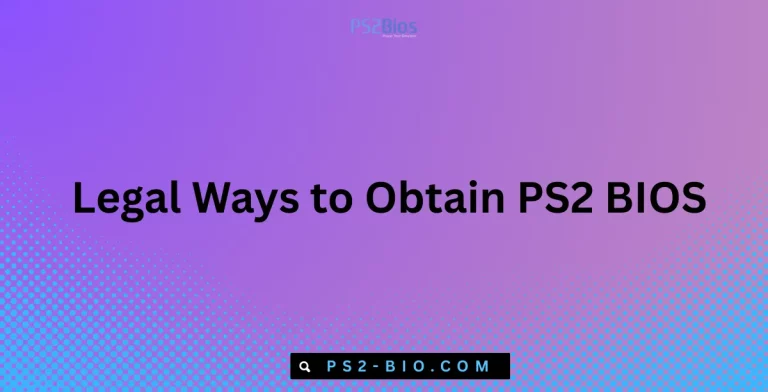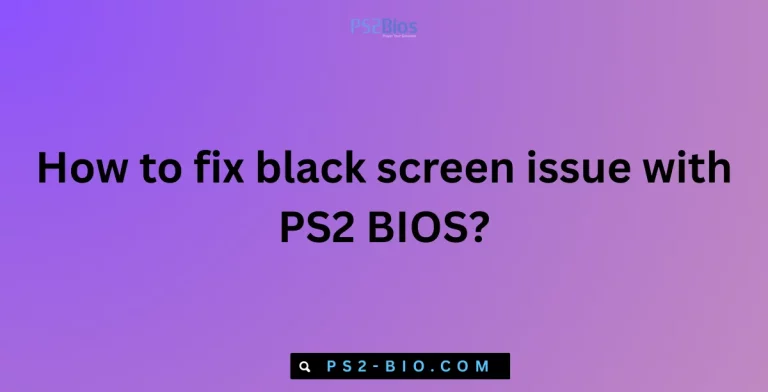PS2 BIOS and Firmware Updates: Did Sony Ever Release BIOS Updates?
Have you ever wondered if Sony released BIOS updates for the PlayStation 2 like they do for modern consoles? The answer surprises many players. Understanding how the PS2 BIOS worked reveals why updates were handled differently and why emulation requires it.

What Is PS2 BIOS?
The PS2 BIOS (Basic Input Output System) is the core software built into every PlayStation 2 console. It manages essential functions such as:
- Booting game discs
- Authenticating region codes
- Managing memory cards
- Loading system settings
Without the BIOS, the console cannot start. Unlike standard software, BIOS is written into firmware chips on the motherboard. This design ensured stability, but it also meant that changing or updating the BIOS was not easy for Sony.
BIOS vs. Firmware: Are They the Same?
People often confuse BIOS and firmware, but in the PS2 they overlap.
- Firmware: Refers to all low-level system software stored permanently in chips.
- BIOS: A specific part of firmware that initializes hardware and system functions.
In short, the PS2 BIOS is firmware, but not all firmware on the PS2 is BIOS. This distinction matters when discussing updates.
Did Sony Release BIOS Updates for PS2?
Unlike the PlayStation 3, PS4, and PS5, the PlayStation 2 never received official BIOS updates. Sony never distributed downloadable BIOS files, nor did they release patches for existing consoles.
The BIOS remained static once the console left the factory. Each PS2 shipped with a pre-installed BIOS version, and the only differences came from hardware revisions across console models.
For example:
- SCPH-10000 to SCPH-39000 models used early BIOS versions.
- Later slim models like SCPH-70000 and SCPH-90000 included updated BIOS to support hardware changes.
Instead of issuing BIOS updates, Sony released new console revisions with updated firmware burned into chips at production.
Why Sony Never Released PS2 BIOS Updates
There are several reasons Sony avoided public BIOS updates for the PlayStation 2:
- Hardware Integration
- The BIOS was tied closely to the Emotion Engine CPU and I/O hardware. Updating it could risk system instability.
- Disc-Based Security
- Games carried built-in protections. Sony ensured that only properly manufactured discs worked with the existing BIOS, avoiding piracy risks.
- No Online Infrastructure
- Unlike the PS3 and newer systems, the PS2 had no universal online update system. Only a minority of players used the optional Network Adapter.
- Manufacturing Cost Efficiency
- Instead of patching consoles, Sony released new models with built-in firmware changes. This approach simplified support while reducing technical risks.
Differences Between PS2 BIOS Versions
Although Sony never released public BIOS updates, different PS2 models shipped with unique BIOS versions. Key changes included:
- Boot Logos: Early Japanese PS2 units displayed different startup animations compared to later global releases.
- Region Locking: BIOS versions enforced DVD and game region compatibility.
- Hardware Support: Slim models had BIOS updates to support smaller designs and revised laser assemblies.
- Bug Fixes: Some early BIOS issues, like memory card glitches, were resolved in newer hardware runs.
These BIOS versions were never user-installable. They only existed on consoles manufactured with them.
How BIOS Affected Game Compatibility
The PS2 BIOS played a major role in game compatibility. For example:
- Certain Japanese games would not load on North American or European systems due to region restrictions in the BIOS.
- Slim PS2 models sometimes improved disc reading stability, thanks to updated firmware.
- Developers relied on BIOS functions for memory card management, ensuring consistent performance across regions.
This is why emulators like PCSX2 require the original BIOS to replicate authentic hardware behavior.
PS2 Firmware vs. Disc-Based Updates
Some players recall certain discs updating the PS2 system. But this was not a BIOS update. Instead:
- Network Access Discs (bundled with the Network Adapter) installed drivers onto memory cards, not BIOS.
- DVD Player Updates: Sony provided DVD Player upgrades through discs, improving movie playback. These updated a separate firmware module, not the main BIOS.
- Game Patches: Rare titles with online functions sometimes stored configuration data, but this did not modify the BIOS.
Thus, Sony’s approach was modular updates via software discs, leaving the BIOS untouched.
PS2 BIOS and Emulation
For emulators like PCSX2, the BIOS is essential. It allows the emulator to:
- Boot games accurately
- Enforce memory card functions
- Emulate system behavior
Since Sony never distributed BIOS legally, players must dump the BIOS from their own PS2 console. Distributing BIOS files online is illegal, which is why emulation guides stress using your personal console.
PCSX2 supports multiple BIOS versions, meaning users can test compatibility differences between early and late PS2 models.
Why This Matters Today
The lack of BIOS updates has two lasting effects:
- Preservation
- Emulation relies on extracting original BIOS files, ensuring the PlayStation 2 legacy survives even without official updates.
- Security Against Piracy
- By not offering public BIOS updates, Sony minimized risks of BIOS hacking, which could have increased piracy during the PS2’s active years.
FAQ: PS2 BIOS and Firmware
1. Did Sony ever release PS2 BIOS updates?
No, the BIOS was never publicly updated. Only new hardware revisions had different BIOS versions.
2. Can I update my PS2 BIOS today?
No. The BIOS is locked into the hardware. You cannot install updates like on modern consoles.
3. Why does PCSX2 need the BIOS?
Because the BIOS initializes system functions, memory cards, and game authentication, making it essential for accurate emulation.
4. Are PS2 BIOS downloads legal?
No. Only dumping the BIOS from your own console is legal. Downloading from the internet violates copyright law.
5. What about PS2 DVD player updates?
Sony released DVD Player firmware upgrade discs, but these were separate from the main BIOS.
Key Takeaways
- Sony never released downloadable BIOS updates for the PS2.
- Every console shipped with a fixed BIOS, only altered through hardware revisions.
- Updates occurred through new console models and separate DVD player firmware discs, not BIOS patches.
- Emulation requires legally dumping the BIOS from a physical PS2.
- This design helped preserve system stability and reduced piracy risks.






